- Home
- David McCullough
The Great Bridge Page 14
The Great Bridge Read online
Page 14
So it would be 1869 before the bridge was at last under way. And it would be the end of that summer of 1869, a full two years later, before things were finally settled behind the scenes. By then, of course, Roebling was dead. And only then did William Tweed emerge publicly as one of the leading spirits behind Brooklyn’s bridge.
6
The Proper Person to See
Who owns the City of New York today? The Devil!
—HENRY WARD BEECHER
ON THE MORNING of September 17, 1869, William Tweed took the Fulton Ferry to Brooklyn. The day was fine, the sun shining, a light, cool breeze blowing over the water. Tweed had a strong attachment to the river. Its sounds and smells, South Street and the ships docking there, were part of the New York he had known since childhood. Twice, when he was an alderman, he had voted to establish additional ferry lines to Brooklyn, in return for which he had been nicely reimbursed with several thousand dollars in cash. He was much younger then and that had seemed a handsome sum. But for his vote for the ferry to Brooklyn’s predominantly Irish Williamsburg section, he had also received a promise of support for his Congressional ambitions. The Williamsburg people had proved as good as their word and in 1853 he had gone off to Washington, a Congressman at age twenty-nine. The life on the Potomac had had no appeal for him, however, and he gladly gave it up after a single term. There were better things to be doing at home.
Now, as the big boat swept out into the river, its bell clanging, there stretched behind him the largest, richest, noisiest city in America, over which he and a few indispensable associates ruled supreme.
New York then, as later, was the country’s financial capital. It was the seat of mighty newspapers—Greeley’s Tribune, James Gordon Bennett’s Herald, the Sun, the World, the Evening Post, the Times. It was the place where fashions were decided on and the center of fashionable society. It was home for the Astors, and it was home for P. T. Barnum, Samuel F. B. Morse, and Herman Melville. New York set the example, as somebody said. It had power, style, more Jews, more Irish, more priests and pickpockets and private art collections, more of just about everything than any city in the country. There were hotels with French waiters and five hundred rooms, theaters numbered in the twenties. As a contemporary book on the city stated on its opening page, Broadway, the principal street, was “paved, policed, and lighted for fifteen miles.” Pretty girls and rich men were too plentiful to count.
From the Battery northward for five miles or so, nearly every last piece of available space had been built up, and on toward the outskirts, near the new park, which had been so optimistically named Central Park, the city had a “straggling, unfinished look.” Downtown the noise was fearsome most of the day, the traffic terrible, the air thick with the smell of horse manure. Along Broadway the fast-moving throngs were more than the average person could take for very long and most women would have agreed with the Reverend Mr. Beecher’s famous sister, Mrs. Stowe, never a timid spirit, who wrote a friend that New York “always kills me—dazzles, dizzies—astonishes, confounds, and overpowers poor little me.”
Strangers to the city sensed an uncommon and offensive preoccupation with self-interest and the almighty dollar. “The light of Mammon gleams on nearly every face in Broadway and Wall Street,” wrote a visitor from England. And two years earlier, after arriving from California, Mark Twain said of New York, “Every man seems to feel he has got the duties of two lifetimes to accomplish in one, and so rushes, rushes, and never has time to be companionable—never has time at his disposal to fool away on matters which do not involve dollars and duty and business.”
Contrasts were everywhere, sharp and frequently appalling. The glistening new carriages that streamed through Central Park on Sundays reminded one French traveler of filigreed jewelry, but of the domain of the Irish and the Negro, between Broadway and the Hudson, the same man wrote, “Nothing could be more depressingly miserable than these wooden hovels, these long muddy streets, and this impoverished population.” An English writer said the whole city, generally speaking, was “one of the worst lighted, worst paved, worst kept cities in the world.”
Homeless children loose in the streets numbered in the thousands. The permanent floating population of homeless children, beggars, drifters, petty thieves, and prostitutes was said to be perhaps 100,000. Bawdyhouses advertised openly in the newspapers. Prostitutes were said to be “more numerous, more dangerous and more shameful than anywhere else on the continent.” Probably that was so. The most influential woman in town was an abortionist, Madame Restell, who lived in a big showy house on Fifth Avenue, across from where the new St. Patrick’s Cathedral was being built.
But nowhere else was quite so much happening every day or was there so much opportunity for the young, the talented, the ambitious, not to mention the lucky or the unscrupulous. Yesterday’s ragpicker or coal heaver was today’s millionaire (a new word). It not only happened in stories, it happened. A. T. Stewart had once been an ordinary shopkeeper, living over a store with his wife in a single room. Cornelius Vanderbilt began penniless, everyone knew.
The city was the undisputed center of the new America that had been emerging since the war. It was a place of a thousand and one overnight schemes, some brilliant, some preposterous, some plain evil, and all, it seemed, calling for enormous outlays of capital and pure nerve. It was the great gathering place for every imaginable kind of promoter, inventor, pitchman, entrepreneur, self-proclaimed visionary or ordinary crook, and nobody, it seemed, could remain bored there for too terribly long, whatever his condition.
Moreover, if only New York could have produced a Jim Fisk or a Tweed, as its critics liked to say, perhaps only New York could have produced a Peter Cooper or a Thomas Nast. And while the opening of the West was the great, popular human drama of the time, New York was the central attraction of a smaller, less celebrated, and colorful, but no less important and purposeful, migration in the opposite direction—eastward to the big cities. “The West is best for the person who is seeking a home,” wrote a young Swedish immigrant upon arriving in Kansas in June of 1869, but added, “The East’s large cities offer a rich field for clever money lovers,” thereby crystallizing what to him and countless others like him seemed the two most compelling and divergent choices in American life. And as he and his kind streamed out onto the American plains, it was to New York that a Mark Twain headed from the gold fields of California or an only moderately rich young Andrew Carnegie moved from Pittsburgh, or that an even younger and penniless Thomas Edison of Ohio would set himself up in business that same June.
Tweed, as it happens, had been called upon to journey all of a few city blocks to find his promised land. He had been born just to the east of City Hall, toward the river, at No. 1 Cherry Street, a squat red brick house that stood beside No. 1 Cherry Street, which, ironically enough, had once, briefly, been the nation’s first Presidential mansion, the home of George Washington when he took office for the first time and New York was the capital. Both of the houses, Tweed knew, would have to be demolished to make way for the anchorage of the new bridge.
Tweed’s people were hard-working Scotch Protestants, and Cherry Street when he was a boy was still considered a respectable neighborhood. It was said he had been a good student, at mathematics especially, and he had started off quite conscientiously, bookkeeping in a mercantile store. But about the time he reached his full growth, he joined up with a volunteer fire company and discovered politics.
In 1851 the fireman became an alderman, being elected to that Common Council of New York destined to be known as “The Forty Thieves.” From that time on, he would find honest work no longer necessary.
By 1869 Tweed was nearing his zenith. Like Beecher across the way, he was right in his prime. He was School Commissioner, Assistant Street Commissioner, President of the Board of Supervisors of the County of New York, Senator of the State of New York, Chairman of the Democratic Central Committee of New York County, and Grand Sachem of Tammany Hall, the title that
pleased him most.
But Tweed was also one of New York’s principal landowners. He was on speaking terms with the rich and powerful, some of whom he also did business with, and he was an extremely generous advertiser in the newspapers. He was in the printing business. One way or another, thousands were in his employ, including several hundred prominent Republicans. Judges rendered decisions according to his requests. Legislators passed or defeated laws as he determined. The Mayor, the charming A. Oakey Hall, did as Tweed wanted and the same could be said of the Governor, John T. Hoffman, who if not an outright stooge was at least “pliable.” As Samuel Tilden would write, it was the first day of January 1869, when Oakey Hall took office, that the Tweed Ring “became completely organized and matured.”
It was also in 1869 that Thomas Nast began his brave, brilliant attack on the Tweed Ring in the pages of Harper’s Weekly, so vividly characterizing Tweed that the true shape and nature of the man would seem to recede and the cartoon figure would become the real Tweed in people’s minds, then and in generations to come. He would be seen as a gross, half-comic character done in quick, sure black line, a figure of corruption incarnate, leering, lecherous, Falstaff with a stickpin.
The portrayal was deadly, as no one knew better than Tweed himself. “I don’t care a straw for your newspaper articles,” he is said to have exclaimed when under attack from the press, “my constituents don’t know how to read, but they can’t help seeing them damned pictures.” But it was caricature, for all that; the man was something else again. He was no less corrupt certainly, but he was very much of flesh and blood, and apart from everything else that was said about him, it seems he was both extremely bright and enormously likable.
The Tweed on board the ferry to Brooklyn that September morning was in his mid-forties, married, the father of eight children. What hair he had left was a dark reddish-brown, which he wore in thick clumps about his ears. His mustache was approximately the same color, as was his short, stiff beard. The eyes were bright blue.
But it was the fantastic physical size of the man that set him off in any gathering. He stood five feet eleven, yet he seemed much bigger than that. He had an abnormally big head, big hands, big neck, great, thick sloping shoulders, and a vast, belligerent stomach across which was draped a heavy length of gold watch chain, a gift from his old fire-fighting pals of the Americus Engine Company Number 6. Estimates are that Tweed weighed somewhere near three hundred pounds.
James Bryce, the English historian, who watched Tweed in action with total fascination, considering him one of the phenomena of the American political system, wrote that Tweed’s size was an important part of his professional equipment, since it made the role of “the genial good fellow” that much easier. And by almost every account, Tweed was a most amiable fellow indeed, buoyant, booming, with a fund of stories and a gift for making friends quickly and easily. “Tweed had an abounding vitality,” Bryce wrote, echoing John Roebling’s view of what counted for success, “free and easy manners, plenty of humor, though of a coarse kind, and a jovial swaggering way which won popularity for him among the lower and rougher sort of people.”
Like numerous other swindlers in high places, before and since, Tweed was known to have his “good side”—a combination of small but popular virtues that were taken by thousands upon thousands of loyal followers as obvious proof that he could not possibly be the monster his enemies described. He drank but sparingly. He smoked not at all. He was a devoted, generous father. He was exceptionally charitable. (Come a hard winter, no family in his district went without coal.) And although he kept at least two mistresses, one of whom, a tiny blonde, did not reach his shoulder, he was considered quite charming in his way by the ladies. He loved to dance. He was never ever arrogant. And perhaps most important of all, as Bryce said, he was always loyal to his friends.
But all that aside, Tweed had a genius for organizing things, and more than any other man of his time, he knew how to make politics pay. Precisely how much he and his cohorts managed to steal from the people of New York will never be known for certain, but responsible estimates range from $75 million to $200 million. Tweed himself, personally, probably made off with $30 million before he was deposed.
When the ferry docked at Brooklyn, Tweed went up Fulton Street to the Gas Light Company offices. He had come to attend the very first meeting of the new Executive Committee of the Bridge Company, of which he was one of just six members.
The full committee was present according to the official synopsis of the meeting: “Messrs. H. C. Murphy, S. L. Husted, Wm. M. Tweed, J. S. T. Stranahan, Hugh Smith and H. W. Slocum.” The committee had been formed at a directors’ meeting the week before. From here on, it had been agreed, the committee was to make all arrangements for the work and have full control over the business of the company. It was to decide on all appointments, purchase all lands required, decide on all contracts for supplies, audit its own accounts, appoint its own attorney (Alexander McCue), and determine all salaries and all other “compensations.”
Tweed’s interest in the bridge was not new, but only on August 3, following the Roebling funeral, had his name been associated with the great work in any public way. An important directors’ meeting had been held at the Gas Light Company. Colonel Roebling was officially appointed Chief Engineer and six new directors were named to fill the vacancies caused by one death and a total of eight resignations, all quite sudden it seems. Three of the new directors were Brooklyn men—Stranahan, General Slocum, and John W. Lewis. The three others were from New York—Tweed and two of his closest associates, Hugh Smith and Peter Sweeny.
Smith was a Republican, a bank president, and a dear friend of Boss Tweed’s, who had made Smith Police Commissioner. Sweeny, also known as Peter “Brains” Sweeny, was a pudgy, black-haired, sinister-looking man who had been called the sneak thief of Tweed’s entourage, but who preferred to describe himself humbly as “a sort of adviser” to the Boss. Like Tweed, Smith had been named a member of the powerful new Executive Committee and so had the pleasure of watching Tweed perform his first recorded service on behalf of the bridge.
As was frequently his way when commencing an association with a grand public endeavor, Tweed wanted an eminently respectable name also associated with it from the start. So as the Executive Committee got down to business, he urged that Horatio Allen be appointed consulting engineer at an annual salary the same as young Roebling was to get, eight thousand dollars, and that the appointment date from August 1, even though Allen had had no hand in any of the work during that time. A formal motion to that effect was presented, passed, and the genial Allen, who was present, immediately accepted. Then, after a few brief formalities were seen to, the meeting broke up and Tweed went back across the river.
There had been no fanfare of any kind and on the surface it might appear that little of importance had been accomplished. But Tweed doubtless felt he had put in quite a good morning.
The sudden death of the elder Roebling had created the single possible flaw in the venture, as Tweed saw it; so he had moved to solve that—or to appear to solve it, which was more important. Irrespective of the skills possessed by the young engineer, without the father in command, a failure of public confidence might develop and bring the bridge to a halt, something Tweed did not want. Tweed was anxious that this project continue for quite some time to come. But now young Roebling was backed up by an engineer of his father’s vintage, whose professional standing was well known, whose character was unimpeachable, who was a founding member of the Union League Club, and so forth. If anyone should one day care to check the record to see who had put him there to safeguard this vast and important undertaking, he would find the name “Wm. M. Tweed.” (Horatio Allen’s professional contribution to the work in the next few years would add up to just about nothing.)
The Tammany chieftain had also made his first entrance onto the Brooklyn scene and not a stir had resulted. He had gone to Brooklyn in good faith and in broad daylight, he had been se
en on Fulton Street, he had taken a place among such upright gentlemen as General Slocum and Henry Murphy, he had fixed his name to the greatest municipal enterprise of the day, and no one had raised a hand or a voice to stop him.
For nearly two years more Tweed would play a decisive part in the business of the Bridge Company, traveling to Brooklyn to attend stockholders’ meetings or to serve on the Executive Committee when it served his purpose. He would make no secret of his interest in the bridge, nor did anyone else try to hide, or gloss over, the obvious fact that his was a very powerful voice in bridge affairs. But when it came time for Tweed to explain the earlier stages of organizing the Bridge Company—that business transacted prior to his open association with the project—everything he said would be angrily denounced by the two principals in his version of the story, William Kingsley and Henry Murphy.
Murphy stated there was no truth whatever in anything Tweed said. He denied absolutely playing the role Tweed credited him with, claiming he and Tweed had had no dealings concerning the bridge. And he stuck to that until his dying day. Which one of them, if either, was telling the whole truth will never be known.
But according to Tweed’s version of the story, Murphy was a very different sort of man from the one Henry Stiles depicted and perfectly capable of Tweed’s brand of politics if that was the only way to get what he was after. In late 1867 or early 1868 Murphy had been after a pledge from the City of New York to subscribe to a million and a half dollars’ worth of bridge stock. (Brooklyn’s subscription, exactly twice that amount, had been arranged quite smoothly. The three million dollars from Brooklyn was all set. The remaining shares, a half million dollars’ worth, were to be sold to private citizens.)

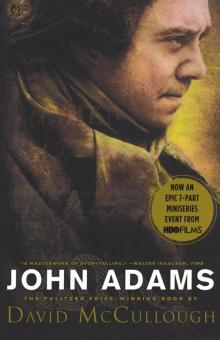 John Adams
John Adams The Greater Journey: Americans in Paris
The Greater Journey: Americans in Paris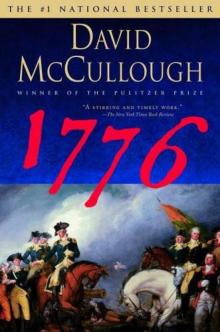 1776
1776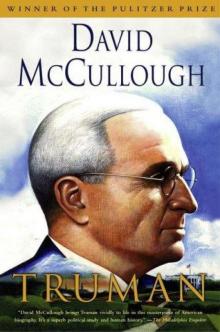 Truman
Truman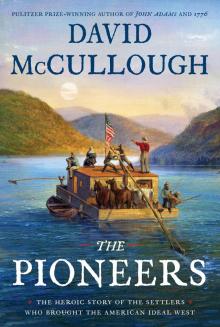 The Pioneers
The Pioneers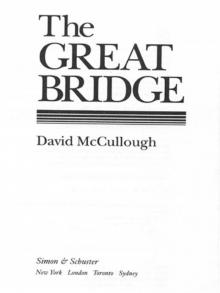 The Great Bridge: The Epic Story of the Building of the Brooklyn Bridge
The Great Bridge: The Epic Story of the Building of the Brooklyn Bridge The American Spirit
The American Spirit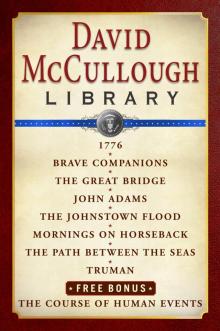 David McCullough Library E-book Box Set
David McCullough Library E-book Box Set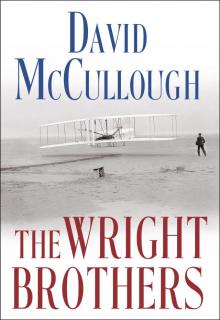 The Wright Brothers
The Wright Brothers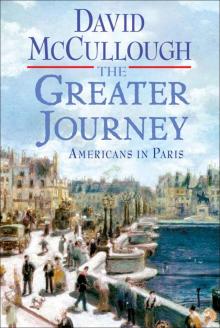 The Greater Journey
The Greater Journey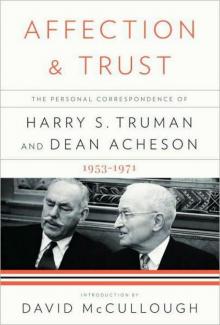 Affection and Trust: The Personal Correspondence of Harry S. Truman and Dean Acheson, 1953-1971
Affection and Trust: The Personal Correspondence of Harry S. Truman and Dean Acheson, 1953-1971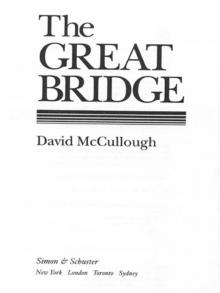 The Great Bridge
The Great Bridge